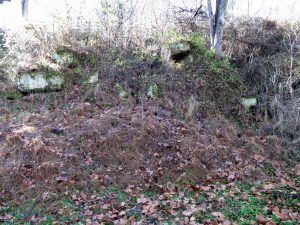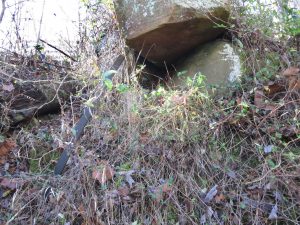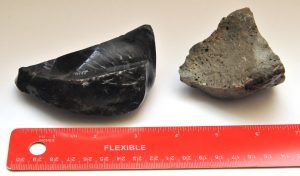I visited the ruins of the Star Furnace on June 28, 2015 and interviewed the current owners of the land, Greg and Phyllis Brainard Bush. This article details that visit.
The Star Furnace produced iron from locally mined iron ore, locally made charcoal, with locally mined coal replacing charcoal in about the last 4 years of production. The furnace ran from 1848 to 1873. Rist, Iron Furnaces Hanging Rock, p101
The Star Furnace sits on a flag lot off US 60 in the Carter County community of Star.
Note that the furnace site sits totally on private land. It is not a public park.
The GPS location of the actual furnace is 38.352434, -82.800014. This GPS position is accurate to within a few feet.
Click here for a Google Maps Link to the Star Furnace (red teardrop is at the base of furnace).
The furnace is located about 265 feet almost due south, and just across Star Creek, from the Star Furnace Historical Marker on the south side of US 60. The GPS location of the historical marker is 38.353151, -82.799877.
Due to a thick overgrowth of trees, bushes, vines, small plants, and 150 years of vegetation build up the remaining part of the furnace is very hard to see. The owner Greg Bush indicated that a few years ago he had goats that had consumed a lot of this vegetation around the furnace and a lot more was visible than when I visited. Since the goats have not been there for a few years the vegetation obscures most of what is left of the furnace.
The furnace was constructed of brown sandstone. The sandstone was likely quarried on site. There are outcroppings of this same brown sandstone very near the furnace that have exposed flat faces that have obviously been tooled.
The upper part of the furnace has fallen down but some parts near the base remain. There is also sandstone block rubble from the fallen upper furnace collected at the furnace base, and other sandstone blocks are strewn about the general area in a haphazard fashion. Some are in Star Creek (aka Rachel Branch). One such stone in Star Creek has a tooled hole completely through the stone. Click on the image for a larger view of this rubble.

External iron ring bands 3 or 4 inches wide were evidently used to keep the sandstone furnace structure from bulging out. These worked like an iron girdle. These iron bands still lay in the rubble pile. You can see one of the iron bands in the image below. Click on the image for a larger view.

The base of the furnace is within 65 feet of Star Creek. So water for various necessary furnace functions, such as cooling the poured molten iron, would have been very convenient.
The furnace is jammed tightly against the base of a hill rising from the flat flood plane of Star Creek. So, the top of the furnace would have been very close to the side of this hill.
Directly above the furnace, on this hill rising from the flood plane of Star Creek immediately beside the furnace, a large flat area has been gouged out of the hill. This flat area on the hill was used to queue up locally mined iron ore, charcoal (and in the very last years mined coal) and other raw materials to charge the furnace from the top. The property owner’s house sits on what looks like either part of this material loading flat, and / or a recent extension of this material loading flat.
The raw materials were loaded directly into the top of the furnace via a small catwalk from this flat on the hill. Using Google Earth’s altitude feature you can get a rough measure of the furnaces height. Assuming this flat on the hill was about the same height of the top of the furnace, the furnace would have been about 30 feet high. But note that this is only a very rough way to measure, so it could be off somewhat. But this 30 foot height seems a reasonable estimate, when compared to other area furnaces of the same era (note the definitive publication on Iron Furnaces of he area “Kentucky Iron Furnaces of the Hanging Rock Region”, by Donald E. Rist, indicates Star Furnace Stack was 36 feet high).
Chunks of glass are in the earth everywhere around the furnace. This glass was an unwanted by product of the iron making process. The locally mined iron ore evidently had a lot of sand (silica) and other impurities, so when the iron was produced at high temperatures unwanted glass was also produced. There seemed to be two main types of this glass, a dense black glass that look very like naturally occurring obsidian, and a very light gray-green and more porous and less dense glass. This less dense gray-green glass looks like a mixture of glass with a bit of common furnace slag. I inspected a few pieces of this furnace produced glass laying beside a couple of tomato plants in a small garden right beside Star Creek. The glass has small amounts of iron embedded here and there in the glass material. Click on the image for a larger view of this glass.

There are also many red bricks on or in the ground in the general area of the furnace. They are not traditional firebrick, but brick similar to those used for general building construction. I am unsure where these bricks were manufactured and if they were part of the actual furnace itself. Possibly these red bricks were used in the construction of the necessary associated buildings for mechanisms for the furnace, like buildings to house the machinery for the furnace air hot blast, molten iron pouring facilities, etc.
Greg Bush indicated that there were large chunks of erratically shaped iron scattered about the area in or on the ground that he has discovered over the years, but one has to disturb the earth to see these artifacts.
The basic furnace construction and area facility layout was very like that of two other local iron furnaces in the Williams Creek Basin, Buena Vista Furnace and Princess Furnace. Specifically a furnace very near a creek, shoved up against a hill, with available locally mined iron ore and a fuel source of either charcoal from local timber, or later locally mined coal.
I am most appreciative of both Greg and Phyllis Brainard Bush for their hospitality, kind attention, and help.
Next Article – The 1861 Diary of J Bertrand Norris at Star Furnace, KY
Previous Article – 1860 – Colliers – Making Charcoal in the Williams Creek Basin

we use to live to the right of star furnace in the next hollar ,we use to play around it when i was growing up there. when I grew up there it was on the Hensley property and across the field from the Alexander place